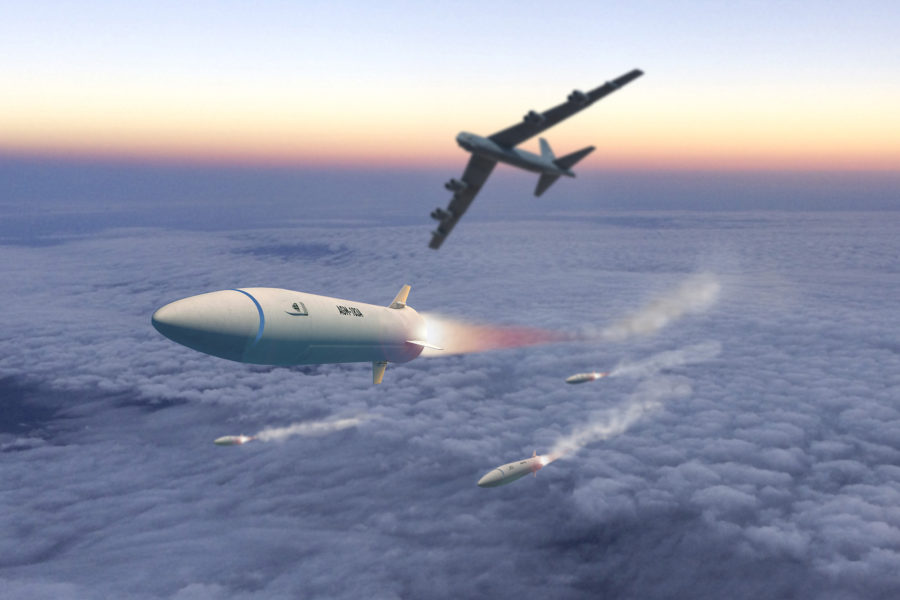To increase coordination and resources for hypersonic weapons development, the House Armed Services Committee included a “National Hypersonic Initiative” in its version of the National Defense Authorization Act. The House panel wants the Pentagon to produce a report, due early in 2023, on how it will build up the hypersonics industrial base and testing infrastructure and what the effort will cost over five years.
In its markup of the fiscal 2023 NDAA, the House committee “notes the multiple programs and efforts” in hypersonics across the armed services and defense agencies but also the “limited industrial base and workforce with the requisite knowledge and infrastructure” needed to develop and test these systems. The HASC is “interested in the potential of an initiative to address current gaps” in the hypersonics development infrastructure “as well as to accelerate production and fielding.” Besides the Air Force, the Navy and Army are pursuing hypersonics programs, as are the Missile Defense Agency and NASA.
Pentagon and industry officials welcomed the attention to hypersonics but said much of what the language calls for is already happening.
The HASC version of the NDAA directed the Secretary of Defense to submit a report to the committee by Feb. 1, 2023, “on potential options to establish” a National Hypersonic Initiative, which will specify:
- “Innovative solutions” to create “leap-ahead technologies” for accelerating and increasing production capacity of hypersonic systems “across the current programs of record within the military services,” to include the potential use of government-owned, contractor-operated (GOCO) facilities.
- Ways to strengthen partnerships with academia and the private sector “with regards to [the] technology and producibility” of hypersonic weapon systems.
- Areas in which the Pentagon can “collaborate across the interagency” to improve hypersonic development and testing capabilities.
- Allies who are interested in collaborating on hypersonic technologies and who are able to make a substantive contribution to the knowledge base or actually co-develop or co-produce some systems.
- “Other relevant lines of effort or work areas” determined by the Secretary of Defense.
An amendment offered by Rep. Doug Lamborn (R-Colo.) would specifically direct the Secretary of the Air Force to “upgrade the air-breathing test facilities” of the service “to support critical hypersonics development.” Lamborn wants the Air Force to complete any such upgrades within two years after starting them.
In a press statement, Lamborn also said the language provides $600 million “to accelerate testing” and development of hypersonic systems, including advanced defensive capabilities.
“The top-line amendment … will put important funding behind this effort and will go a long way toward helping us catch up with Russia and China on hypersonics.”
During a House Appropriations hearing, there was discussion of restoring funds withdrawn from the hypersonic AGM-183 Air-launched Rapid Response Weapon program (ARRW), but the panel voted not to do so.
An industry source said the House’s sense that there needs to be national coordination on hypersonics echoes a report from the Government Accountability Office in 2021 “that said the same thing … It’s been an ongoing theme, and there’s some truth there.”
Mark Lewis, head of the National Defense Industrial Association’s Emerging Technologies Institute and former Pentagon director of research and engineering, said, “I’m all for” a national hypersonics initiative, but “it’s kind of what we were doing in the last administration.”
The initiatives spelled out by the House match those put forward by Michael White, the Pentagon’s principal director for hypersonics, said Lewis, a hypersonics expert.
“Congress set up the Joint Hypersonics Transition Office,” he said, “and its job was exactly this, to coordinate across the department.” However, he said, “It’s still a work in progress … we can always have better coordination.”
Lewis applauded the House’s attention to hypersonic test capability, noting that, despite recent efforts, there’s still a shortage of both wind tunnels and live-fly range space.
“We need to do both,” he said, but of the two, Lewis said live-fly should get priority.
“We need to be flying more often,” he said. “We need to get into the air; that’s the ultimate test … We need infrastructure that gets us into the air routinely, not doing these … one or two flights a year. To the extent that the folks in the House can help with that, I think is actually very significant.”
Lewis noted that in the days of the X-15, a well established infrastructure conducted routine hypersonic testing with a recoverable vehicle, which could fly in a designated, over-land hypersonic test corridor.
“We don’t have that anymore,” he said, and restoring such a capability would be a huge boost to hypersonics research.
The reference to allies certainly includes Australia, he said, because Australia’s hypersonic development capabilities “are really quite good” and “they have that beautiful Woomera range,” which is an over-land hypersonic test area.
Overall, though, Lewis offered “hearty applause” for the language.
“This needs to be a national priority,” he said, and the fact that it is bipartisan language indicates “they’ve gotten the message, that hypersonics is an important future military capability. And they’ve also gotten the message that we are in a race that we’re currently losing, to deploy this technology.” Lewis also applauded the “setting of a timescale” because peer competitors “already have it, and we don’t.”
